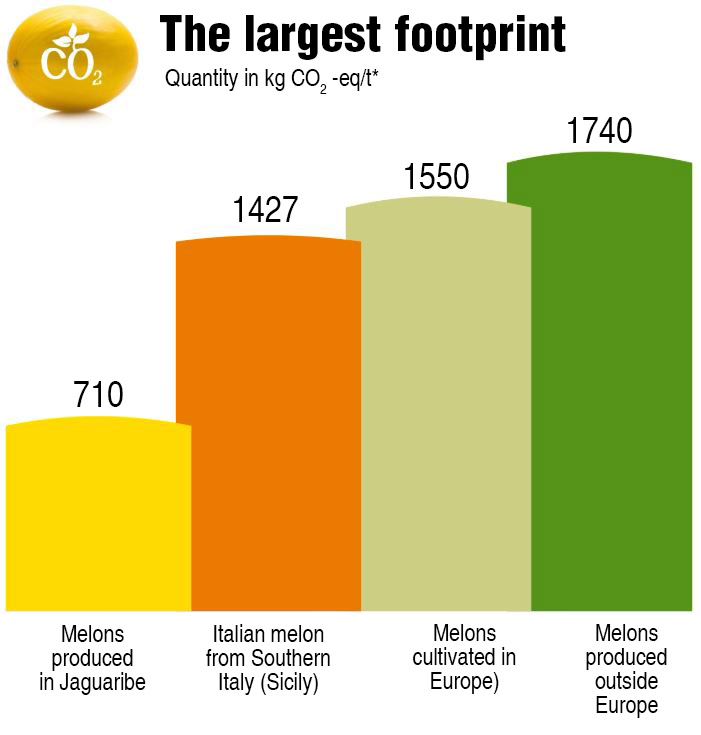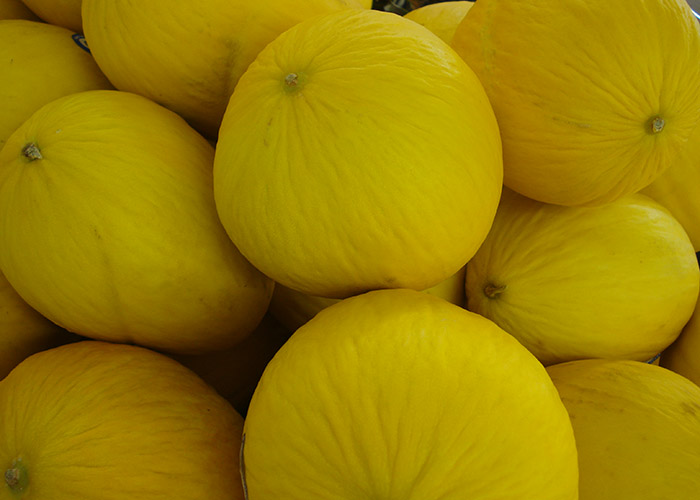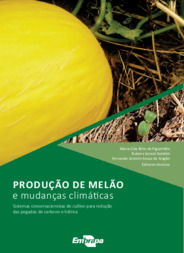Brazilian melon has half the carbon footprint of those produced abroad
Brazilian melon has half the carbon footprint of those produced abroad
The canary melons that leave the Jaguaribe-Açu region - the main Brazilian region producing the fruit - emit half the amount of greenhouse gases that Italian melons cultivated in the region of Sicily, Italy, release into the atmosphere. Other important world producers present similar or even higher emissions than the ones recorded in Southern Italy. Check the comparison in the picture below:
The data were calculated during a comprehensive study of the crop's environmental efficiency, held within melon-producing farms at the Jaguaribe-Açu region, by the Repensa Melão network- a consortium of research institutions and representatives of the melon production sector. The data are available online in a digital publication.
“The research meets a farmers' need. They wanted to measure environmental efficiency to ensure their place in more demanding markets, which seek products with environmental certification”, explains the researcher Maria Clea Brito de Figueiredo, from Embrapa Tropical Agroindustry.

Source: (Cellura et al., 2012), (Audsley et al., 2009). Design: Ana Elisa Galvão Sidrim
*Carbon dioxide equivalent, CO2eq or CO2e, is an internationally accepted measure that expresses the global warming potential of greenhouse gases (GHGs) as opposed to carbon dioxide (CO2).
Water consumption was also assessed
Besides calculating the carbon footprint, the study included the water scarcity footprint, evaluated 24 different production systems and reached a proposal of more efficient models from environmental and economic standpoints. The researchers sought systems that could increase soil carbon stocks, reduce greenhouse gas emissions, and consequently reduce Brazilian melon's carbon footprint.
“It is a study that the sector should have as a reference. Based on the data, each exporter can calculate their own efficiency and work towards improving it”, stresses Clea Figueiredo. The researchers believe that the impact can be formidable, especially after the reestablishment of the normal rainfall regimen in the region, which has faced successive years of dry spells. The Jaguaribe-Açu rural area is responsible for around three-quarters of the harvested area, more than 80% of the production and the near total of Brazilian exports of the fruit.
Greener model is more lucrative
The researchers not only assessed the environmental efficiency of the traditional production model, but they also sought alternatives to reduce the carbon footprint and increase revenue. For this purpose, several alternative cultivation models were compared with the traditional system. The surprise was that the system that is most environmentally efficient in carbon sequestration was also found to be the most economically lucrative.
The environmental and economic champion system was the crop rotation with maize and Brachiaria, incorporating organic matter into the soil, and cultivating melon with the use of polyethylene film (mulching). The production model tested in the Jaguaribe-Açu region presented a positive variation in the carbon stock, considering the soil profile studied (0-40 cm) and the period monitored.
The economic assessment showed that this crop system offers more than a 100% increase in yield when compared with the traditional system, in a scenario considered favorable (regular rains ensuring water for irrigation and interrupted cycle of the main pests). In this scenario, the maize and Brachiaria rotation system presents a yield of 117.90% while the traditional one, 59.69%.
Melon in figures

Design: Ana Elisa Galvão Sidrim
Cheap implementation
The second good news for growers is that the implementation of this production alternative does not require great expenses. The additional investment is of 6%. The study used return on investment (ROI) as an indicator of yield and considered favorable and adverse scenarios. It also assessed risk in more profitable systems.
The Embrapa researcher Pedro Felizardo Adeodato de Paula Pessoa, one of those responsible for the economic feasibility assessesment of the systems, explains that any profitability that is higher than 20% is considered attractive. “In order to mitigate the risks involved, it must be higher than two or three times the profitability offered by the more conservative and low risk investment alternatives”, he clarifies.
Data available online
Any farmer or researcher can access the results, gathered in the book “Produção de melão e mudanças climáticas – Sistemas conservacionistas de cultivo para redução das pegadas de carbono e hídrica” (Melon Production and Climate Change: Conservationist cultivation systems to reduce carbon and water footprints), which is freely available for download. The publication was edited by Embrapa and partners with support from the Coordination for the Improvement of Higher Education Personnel (Capes) and National Council of Scientific and Technological Development (CNPq).
Besides Embrapa, study participants include the Federal Rural University of the Semiarid (Ufersa), the Rio Grande do Norte Agricultural Research Corporation (Emparn) and the Pernambuco Agronomic Institute (IPA). The research on water scarcity and carbon footprint is also being conducted with growers in the Lower Middle São Francisco river region, in partnership with Embrapa Semi-Arid Region, with melons and mangoes.
What is Ecodesign?To assess melon crops, the study applied the concept of Ecodesign, a methodology used to reduce the environmental impact of technological products and processes, which is still at development stages. In general, Ecodesign studies consider the whole or part of the supply, consumption and post-consumption chain, that is, the product's life cycle. Learn five advantages of Ecodesign: 1 – It contributes to sustainable development It is a way to meet consumers' need for more environment-friendly products and services; 2 – It reduces costs. Environmental and economic viability studies at the stage of product development allows changes in processes right at the beginning of the research, when costs of changes are still reduced; 3 – It contributes to competitiveness. Ecoefficient companies can become more competitive, as they do not only reduce costs, but also offer added value for consumers;
4 – It does not transfer problems. Since it uses Life Cycle Assessment, which observes all the stages of a product's existence, it reduces the risks of adopting technological alternatives that only transfer the environmental impacts throughout the chain;
5 – The results of these assessments help in international certifications such as for carbon footprint (ABNT ISO 14067, 2015), water footprint (ISO 14046, 2014) and type III environmental product declaration (ISO 14025, 2006). |
Translation: Mariana Medeiros
Verônica Freire (MTb 01225/CE)
Embrapa Tropical Agroindustry
Press inquiries
agroindustria-tropical.imprensa@embrapa.br
Phone number: +55 85 33917116
Further information on the topic
Citizen Attention Service (SAC)
www.embrapa.br/contact-us/sac/


